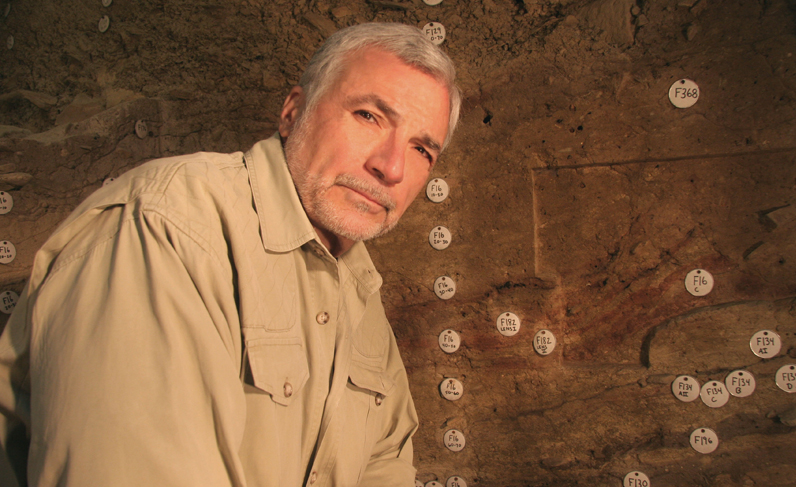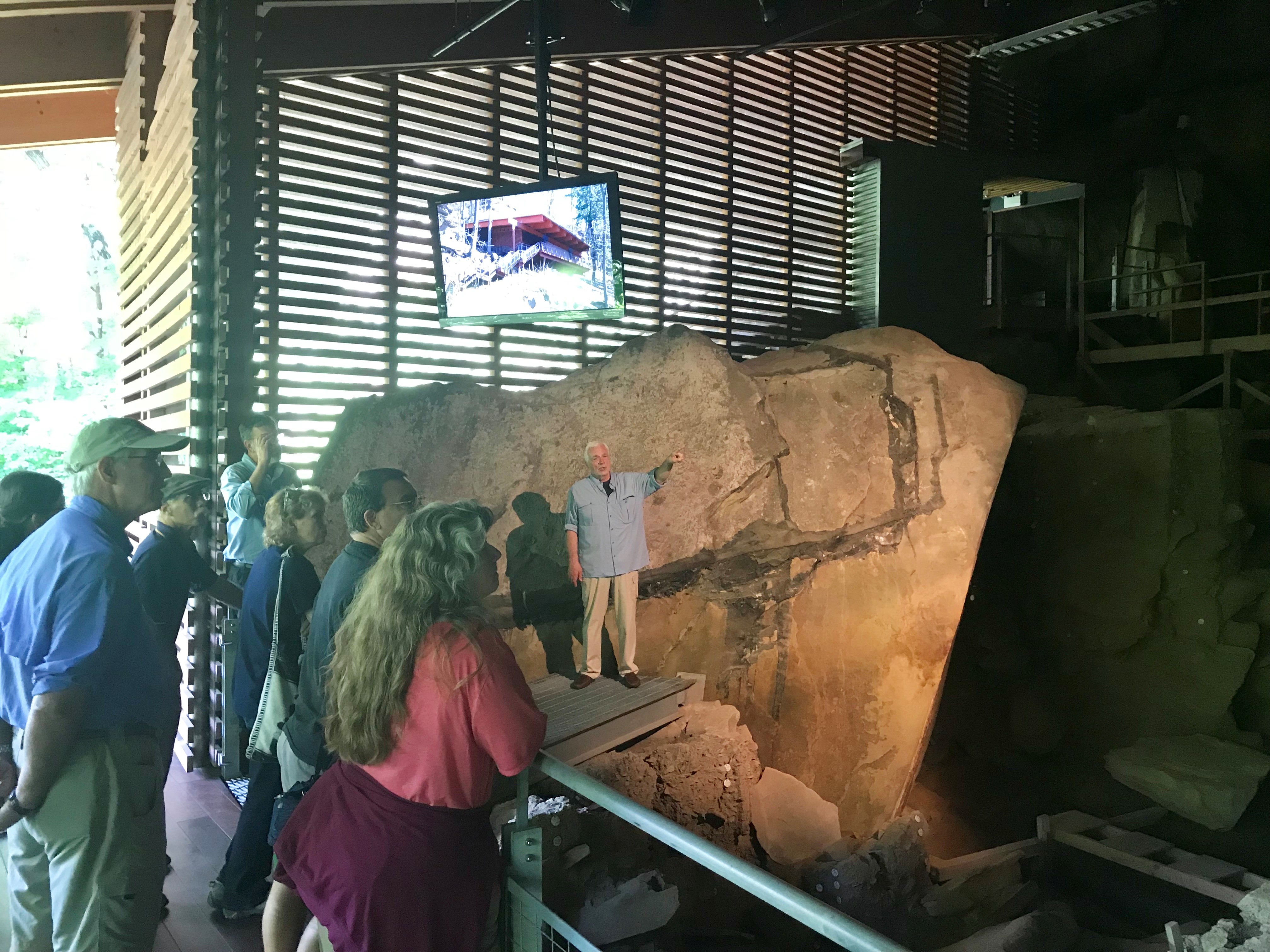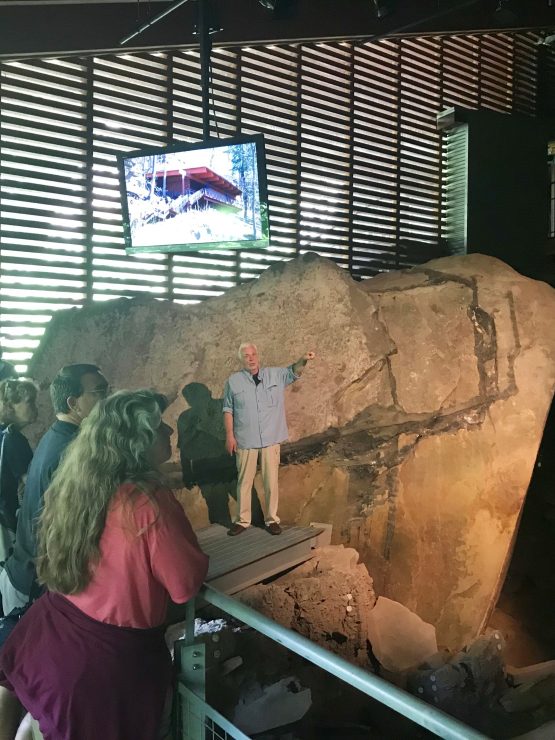In 1973, Dr. James Adovasio and his University of Pittsburgh students conducted an archaeological excavation of the Meadowcroft Rockshelter site on a farm owned by Albert Miller in Avella, Pa. The following year, radiocarbon dating by the Smithsonian concluded the Rockshelter had once served as a campsite for prehistoric hunters and gatherers 16,000 radiocarbon years ago (or 19,000 calendar years).
The evidence made Meadowcroft the oldest site of human habitation to be discovered in North America and catapulted Dr. Adovasio to international fame.
Now a National Historic Landmark, the Meadowcroft Rockshelter welcomes history buffs and archaeology enthusiasts from around the world as they explore the history of humankind.
Keep reading to see what Dr. Adovasio had to say about the excavation, the site’s history, and his annual Insider Tours.
 Meadowcroft: Think back to when you first set foot on Albert Miller’s farm in 1973. Did you have any idea what you were getting yourself into?
Meadowcroft: Think back to when you first set foot on Albert Miller’s farm in 1973. Did you have any idea what you were getting yourself into?
Dr. Adovasio: No, we assumed on the basis of the physical characteristics of the Rockshelter that Albert [Miller] was correct in his supposition that Native Americans had used the site prehistorically. We were also convinced based on other excavations in the immediate study area that it probably was used rather late in time and that it would not contain extensive deposits in terms of the thickness of the layers or in terms of the volume of material. So the answer to the question, very specifically, would be no – we knew we were getting into a prehistoric site, but we did not know how complicated it would turn out to be.
MC: At what point during the excavation did you realize you were onto something big?
DA: Early in the 1973 excavations, which would be in June of 1973, it became apparent that the site was much deeper than we thought it would be, that the deposits in the site were much thicker, or deeper, and considerably older than we had imagined. So by the end of June, or certainly by the end of July in 1973, we were aware that the site was infinitely more complicated than we had imagined.
MC: What do you find to be the most interesting aspect of the Rockshelter’s long history?
DA: I think the most interesting aspect of the site is not its great antiquity, but rather the fact that you have 16,000 radiocarbon years of intermittent human use there [that is] a very detailed, climatic, and environmental record against which you can see very minor changes in climate and with which humans had to interact variably through time. So it’s the length and detail of the record that’s represented there that impressed me personally, more than the age of the site, though that attracted the most attention. That the site proved to be old was more or less icing on the cake that we never anticipated baking, so to speak.

MC: You lead Insider Tours of the Rockshelter every year. Why is it important to continually introduce people to its history?
DA: A lot of people come from a great distance to see [the Rockshelter]. We’ve had people from Europe, Asia, and Australia who specifically came to visit the site. We believe, at least the staff of the Meadowcroft research enterprise, that unless archaeologists can translate what they do to the general and interested public, there’s no point in doing it. Especially since the funding normally derives ultimately from tax dollars that the public is really paying, or from locally-based corporations that are donating funds, or whatever it happens to be, we feel the obligation to tell the Meadowcroft story. And therefore, each time we tell it, we try to alter it a little bit so that we can incorporate the newest results from our ongoing analyses and address questions and issues which the public might be interested in at large.
MC: What are some of the most common questions you get while leading the Insider Tours?
DA: Visitors normally ask where people went when they weren’t on the site, and the answer to that is complicated because it’s very difficult to track prehistoric populations across the landscape where you don’t have excellent preservation of organic material. In other words, there are some parts of the Great Basin in Utah, Nevada, and surrounding areas, where you can actually track a given group in time and space by their product. That’s not possible at Meadowcroft, so we don’t really know where they’re going when they’re not there.
Another question is, do you have prehistoric artwork represented? Because that cliff base erodes so rapidly, had there once been any artwork there, it would’ve disappeared long ago.
Yet another question that’s often asked is, are there human remains at the site? You have discarded human teeth, such as you might in the old days have yanked a tooth out of your mouth that was troublesome, but other human remains we simply don’t have. Because the people that visited the site were visiting in small numbers, the statistical odds even over 16,000 radiocarbon years of someone having died there are very, very low, so there are no burials at the site whatsoever.
It’s surprising, in a general sense, how informed the public is that comes to the site. They know enough in some cases to ask very, very precise questions, and those are just some of the most commonly asked questions.
Dr. Adovasio leads Insider Tours each season. Please visit our events calendar to register for an upcoming tour.
Kim Roberts is the communications coordinator for the History Center.
